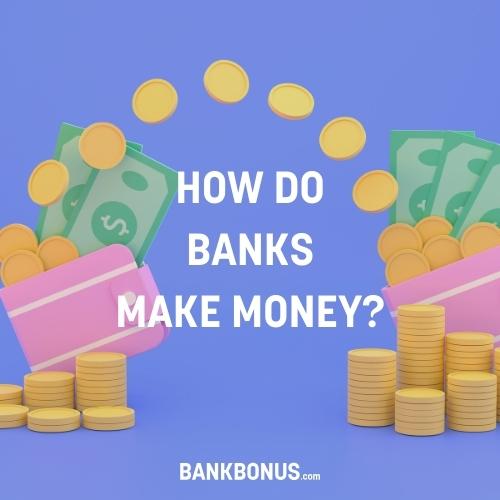Banking is a term that describes how people and financial institutions interact with each other through the transfer of money. From a consumer standpoint, banking is the money management relationship you have with your bank.
For example, if you have a checking account, savings account, or mortgage loan with Chase, you bank with Chase.
Keep reading to learn more about what banking is, the different types of banks, and more so you can do it more effectively.
What Is Banking & How Does It Work?
Banking occurs when a bank accepts and safeguards money from its customers and then lends out that money or invests it to earn a profit. Modern banking as we know it traces as far back as the Ancient Greek and the Roman Empires.
Today, a bank is a federally-licensed financial institution that receives deposits and issues loans or credit. It’s a safe place to store, grow, and borrow money. These services are traditionally available through deposit accounts, credit cards, loans, and other banking products.
Of course, banks do a lot more than just that. Banking services like wealth management, business funding, and retirement planning are standard, especially in bigger banks.
With all of that said, what banking is for one person might mean a different thing for another.
For example, a high school or college student might be okay with just a checking account and a savings account, whereas an established business owner might require more banking services.
No matter where you are in your financial journey, there’s an opportunity to optimize how you bank. Let’s take a closer look at what banking looks like in the United States.
Banking in The United States
In the US, the banking system dates back to the late 1700s and has since become one of the world’s most powerful financial systems. We won’t get into its massive complexities, but the main concept to understand is the idea of a central bank.
For starters, the U.S. Federal Reserve Bank (the Fed for short) regulates all US banks.
The Fed is one of the major central banks in the world. It manages the national money supply, creates monetary policy, and sets member banks’ prime interest rates, among other things.
The modern role of the Fed was shaped by a bit of trial and error. When a global financial crisis occurs (e.g., the Great Depression or Great Recession), it’s not uncommon for the Fed to make policy adjustments.
As a consumer, the Fed is significant because it dictates the overall value of your money. It also determines how much you’re able to earn through interest because the Fed controls interest rates.
Most people never have to think about the Fed in their day-to-day financial lives. However, understanding how money works on a federal level can help you see trends and opportunities within the system.
Types of Banking
There are three main types of banking that you might engage with: retail, commercial, and investment. Let’s go over what you can expect to find from each one.
1. Retail Banking
Retail Banking, also known as consumer or personal banking, is probably what you’re most familiar with. That’s because retail banks provide:
- personal bank accounts
- credit cards
- personal loans
- mortgages
…and other financial services.
You’ll encounter traditional, brick-and-mortar banks, online-only banks, hybrid banks, credit unions within retail banking.
Traditional banks operate in physical branches and have tellers, deposit boxes, and advisors. Online-only banks provide most of the same services but without physical locations, and they generally offer perks like lower fees and higher interest rates on deposits.
The Federal Deposit Insurance Corporation (FDIC) ensures all banks in the US, which means that depositors are protected if they fail.
Here’s a look at the main components that make up retail banking.
Retail Banking Products
- Checking Accounts exist to meet your everyday banking needs. They typically come with a debit card and are most often used for bill pay, funds transfers, and ATM withdrawals.
- Savings Accounts are for long-term money storage and emergency funds. A savings account usually comes with an interest rate, which means you can earn some money on your deposits. Generally speaking, the more money you deposit, the more you can make.
- Certificates of Deposit (CDs) are long-term savings accounts that offer a fixed interest rate in exchange for locking your money in for a specified term. Rates vary depending on your term length and the amount of money you deposit, and there are usually early withdrawal penalties if you need to access your funds before the term ends.
- Credit Cards essentially function as a micro-loan. With a credit card, which banks usually issue, you have access to a specific limit of borrowed funds that you must pay back. If you cannot pay off your card within each statement period, the bank will charge interest on the outstanding balance (which is how they make a ton of money).
- Personal Loans are issued by lenders to borrowers, with an agreement that the borrower will pay it back over time with interest. Personal loans can include student loans, auto loans, and bank loans.
- Mortgages are another form of loan that most people take out from a bank or other lender to buy a home.
2. Commercial Banking
Commercial banking encompasses retail banking. Think of it this way: commercial banks include any financial institution you engage with when you deposit money, take out loans or conduct most other banking transactions.
Commercial banks serve both independent and corporate clients. For example, if you’re a small business owner, you may have a business bank account or a small business loan from a commercial bank.
As an individual customer, the bank where you operate your checking and savings accounts is also a commercial bank.
3. Investment Banking
Investment banking occurs when an investment bank facilitates a complex financial transaction. For example, an investment bank can use its money to provide capital, underwrite the debt, and engage in other capital market activities on behalf of its clients (with the goal of earning a profit).
Typically, investment banks partner with corporations, governments, and other types of entities to help them grow, trade securities, or facilitate mergers, acquisitions, or reorganizations.
Investment banking is a wide-ranging segment of the banking industry. One standard function of an investment bank is serving as an intermediary between investors and a corporation that wants to issue stocks or bonds.
Another common scenario is when an investment bank provides the capital for a large commercial real estate or construction project.
Learn More:
Frequently Asked Questions
Now that you understand what banking is as a whole let’s review some of the most common questions about banking.
What’s the difference between a bank and a credit union?
Within the retail banking sector, you have the option of working with a bank or a credit union. There are two main differences between the two.
The first is that banks are generally open to the public, whereas credit unions are not. You usually need to be a member of a trade group, church, community group, or educational association to qualify for a credit union.
The second main difference between banks and credit unions is how they treat profits. Most banks are either privately owned or publicly traded and operate with the goal of generating a profit (which then flows to shareholders).
Credit unions, on the other hand, are typically member-owned and nonprofit. Its goal is to generate a profit for its members. This profit is then usually passed down in the form of lower fees on loans and other banking services.
Do I need a bank account?
Technically, no — it isn’t a legal requirement to hold a bank account. But these days, not having a bank account is probably going to hold you back.
A relationship with a bank makes financial transactions easier. If you want to own a home, build your credit, or start a business, banking becomes an absolute necessity. Mobile banking also makes it very easy to pay bills and keep track of your cash flow, among other things.
On a smaller scale, a bank account also gives you the peace of mind that comes with knowing your money is in a safe place.
What are the best places to bank?
It depends on what type of banking experience you’re looking for. There’s no shortage of options in the US, with the largest four banks being Bank of America, Chase, Citibank, and Wells Fargo.
Each of these institutions provides comprehensive banking solutions on a massive scale.
Online banking is also an increasingly popular banking option. The lean offerings, low fees, and simple platforms are especially attractive to younger customers.
Overall, the best place for you to bank is the one that meets your unique needs. Make a list of what’s important to you, and go with the bank that aligns with those objectives.
Banking Doesn’t Have To Be Complicated
Banking is a complicated topic that we just scratched the surface of in this post.
The key is to start small and take it one step at a time. Follow simple banking practices like managing your money between a checking and savings account. Then, keep saving money and never spend more than you earn.
You can also look at building up your credit with a low-risk credit card, but always make sure to pay off your balances in full each month, so you don’t go into debt.
Now that you get the hang of how banking works, it’s time to use it as a tool to grow your personal wealth.





Comments are closed.
Comments are closed here.